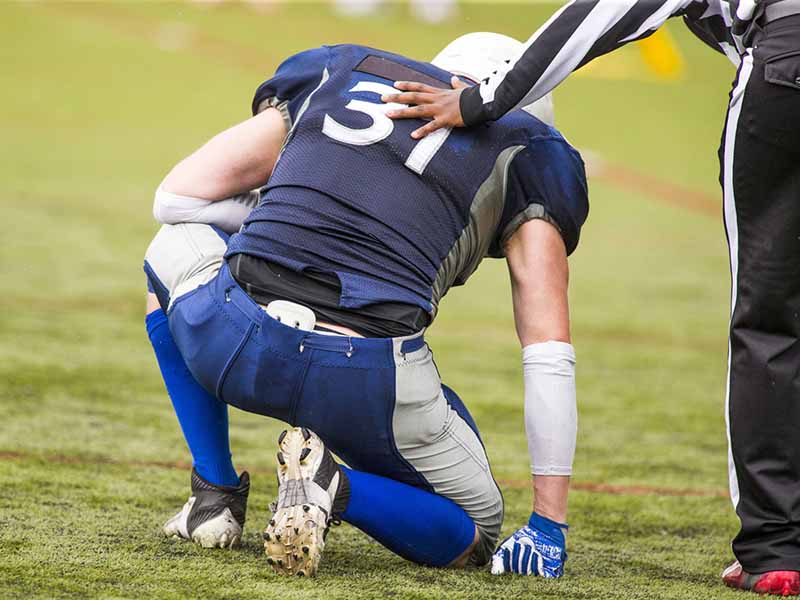Repetitive Subconcussive Impacts Linked to CTE, Study Finds
January 26, 2018, 08:41 am Chris Crawford — A study published online Jan. 18 in the neurology journal Brain linked repetitive subconcussive hits to the head to chronic traumatic encephalopathy (CTE).

The study included input from researchers at Boston University, Cleveland Clinic, Harvard Medical School, Lawrence Livermore National Laboratory in California, Ben-Gurion University of the Negev in Israel and Oxford University in the United Kingdom.
Researchers examined the postmortem brains of four male athletes ages 17-18 who sustained sports-related closed-head impact injuries and died during the acute-subacute period postinjury (i.e., one day to four months). These brains were compared to postmortem control brains from four male athletes ages 17-22 without recent head injury. None of the cases showed evidence of skull fracture, subdural hematoma, subarachnoid hemorrhage or other signs of moderate-to-severe traumatic brain injury.
Microscopic examination of the brains with head injury revealed focal phosphorylated tau protein in two of the four cases, and early-stage CTE in one case. In contrast, none of the control brains showed these or other signs of CTE or other neurodegenerative disease.
The study's researchers also experimented with laboratory mice to replicate sports-related head impacts. The mice were subjected to unilateral closed-head impact and exhibited abrupt onset of transient neurobehavioral deficits with rapid and complete spontaneous resolution.
Story Highlights
"The observed deficits, temporal course and rapid recovery constitute an experimental concussion-like syndrome with phenomenological resemblance to human concussion," the study noted.
The authors said even without concussion, the mice with head trauma still showed changes in their brains, including buildup of the tau protein.
Family Physician Expert's Perspective
Jason Matuszak, M.D., director of the Sports Concussion Center in Buffalo, N.Y., told AAFP News there's enough evidence to suggest a relationship between subconcussive repetitive head impact and CTE.
"What remains unclear is why some people are more predisposed than others," he said. "Also, the original writings on CTE, from the days of 'punch drunk' boxers, suggested motor and memory problems but never discussed related emotional problems or suicidality. This appears to be a relatively recent association."
Matuszak said it should be noted that none of the four injured brains in the study exhibited the "typical" simple, uncomplicated, concussion that occurs and resolves spontaneously.
Additionally, he said it isn't clear whether any of these results would be generalizable to the whole population of athletes playing contact/collision sports or those diagnosed with a "concussion without modifying factors."
The mouse model reinforced some of the hypotheses that have evolved during the past several years related to tauopathy and head injury and how someone could develop CTE without being diagnosed with concussion, Matuszak said.
"At the same time, the mouse model might exaggerate the effects of a traumatic force, given multiple differences between species," he said. "There's a danger to making a leap from a mouse model to a human model. The first studies on second impact syndrome looked at dog models and even those may be wrong."
Flag Football Under 14
The same day the Brain study was released, the Concussion Legacy Foundation (CLF) launched an initiative promoting flag football for kids younger than 14.
"This education program for parents is inspired by the last decade of research on CTE, which has revealed that the best way to prevent CTE in football players is to delay enrolling in tackle football until 14," said Robert Cantu, M.D., co-founder and medical director of the CLF, in a news release announcing the launch of Flag Football Under 14.
The CLF website pointed out that many of the NFL's all-time greats didn't play tackle football until age 14, including Jerry Rice, Jim Brown, Lawrence Taylor, Walter Payton and Tom Brady.
"Based on everything we know about CTE, Flag Football Under 14 makes overwhelming scientific sense," said Lee Goldstein, M.D., Ph.D., associate professor at Boston University School of Medicine and College of Engineering and principal investigator for the Brain study, in the release. "We will never prevent CTE by focusing on concussions. Any meaningful prevention campaign has to focus on preventing all hits to the head, including subconcussive impacts."
As a counterargument, Matuszak suggested that a movement to not teach proper tackling technique until age 14 could actually lead to more injuries because after puberty, players have added body mass and size and will be hitting much harder without the benefit of having learned how to do so correctly.
"This may result in poorer form tackling and inappropriate technique, like using their head to make the tackle," he said.
"I believe there's a role for introducing the fundamentals of good form tackling and blocking early on, but understand the desire to reduce risks where reasonable."
Closing Thoughts
Matuszak said despite these findings, the benefits of sports participation may still exceed the risks for many athletes.
"At the same time, family physicians should encourage athletes to participate in programs that have demonstrated a willingness to work on the fundamentals, such as USA Football's Heads Up program," he said.
Furthermore, if family physicians want to take a more hands-on approach to athlete safety, Matuszak said they should consider working with local schools or club teams to help implement medically reasonable safe standards of play.
"Family physicians should remind their patients that there remain a lot of unknowns about who gets CTE and why," he said. "Not all athletes playing contact or collision sports develop problems, yet some do. There are always risks and benefits with sports."
More From AAFP
Familydoctor.org: Concussion